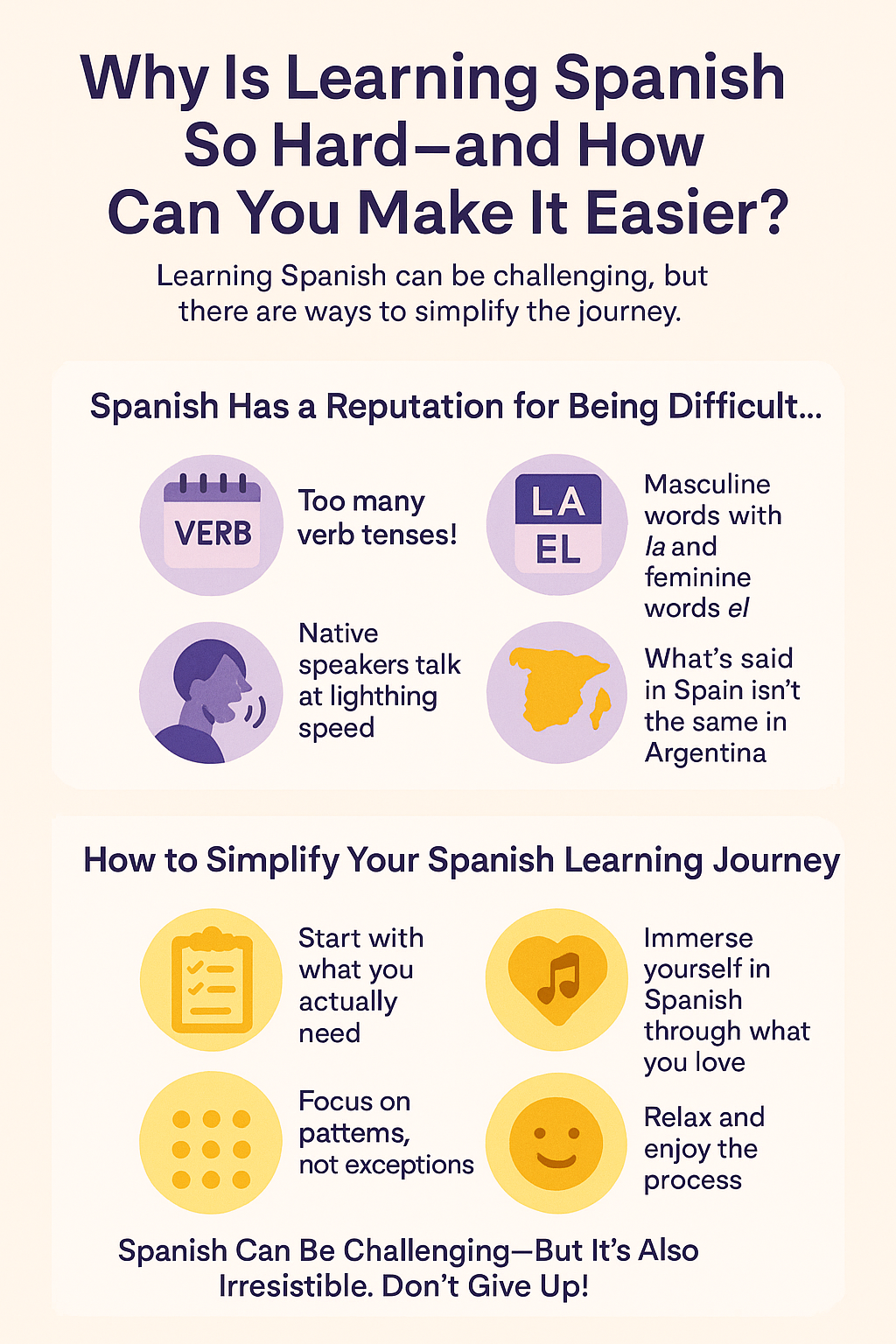Why is it so difficult to learn Spanish and how to make it easier?
Learning Spanish is a wonderful adventure. We dive into a vibrant language full of nuance, emotion, and unmatched cultural richness. Think about it for a moment: it’s no coincidence that some of the greatest writers in history chose Spanish to bring their stories to life.
However, like all things beautiful and valuable in life, mastering it takes effort. All its rules, exceptions, and unexpected twists can make learning Spanish feel like climbing a steep mountain. But trust me—the view from the top is worth it.
If you’ve ever wondered why is learning Spanish so hard?—keep reading! Today, you’ll discover the answer and, best of all, learn how to make the journey easier and even fun. Let’s get started!

Spanish Has a Reputation for Being Difficult… But Is It Really?
First, let’s be clear: learning any new language can be a challenge. But let’s be honest, Spanish has a few quirks that can make you stop and think, what did I just read? Here are some reasons why many people find Spanish difficult to learn:
Too many verb tenses!
Everything’s going fine in Spanish class—until you discover that you have to master things like the past perfect subjunctive or conditional perfect. Just hearing the names sounds intimidating!
Spanish is full of verb tenses. Some are simple, but others can be truly challenging, with conjugations like:
“Si hubiera sabido que vendrías temprano, habría preparado la cena antes.”
If I had known you were coming early, I would have prepared dinner beforehand.
What a challenge!
Masculine words with la and feminine words with el
There’s a pretty simple rule in Spanish: words ending in “-a” are usually feminine (la casa, la manzana, la silla), and words ending in “-o” are usually masculine (el niño, el carro, el cielo).
But… surprise! There are many exceptions:
- El planeta
- El alma
- El arma
- La foto
- La radio
- La mano
So if you’ve ever asked yourself why Spanish is hard to learn, these exceptions give you a clear hint.
Native speakers talk at lightning speed
Another reason people say Spanish is hard to learn is the speed at which native speakers talk.
Have you ever heard a Chilean, Dominican, or Venezuelan speak? They usually speak fast, link words together, and drop syllables. It can seem like there are no pauses—and at first, it’s overwhelming.
What’s said in Spain isn’t the same in Argentina
Spanish varies a lot from country to country. That makes it fascinating—but also a challenge!
For example, in most Latin American countries, torta means cake. But in Argentina, it means a punch.
Now imagine telling an Argentine:
“Ayer preparé una torta de chocolate y quedó riquísima.”
(Yesterday I made a chocolate cake and it turned out amazing.)
Their confused face would say it all!
How to Simplify Your Spanish Learning Journey
Now that you understand why learning Spanish can be hard—don’t worry. There are ways to make it easier and, above all, more fun.
Start with what you actually need
Don’t overwhelm yourself with complicated rules and verb tenses right from the start. Focus on the basics:
- Common phrases
- Essential vocabulary
- Simple past, present, and future tenses
Step by step, you’ll level up without frustration.
Immerse yourself in Spanish through what you love
You don’t need to spend hours reading a grammar book. Learn through what you enjoy:
- Listen to music in Spanish
- Watch movies and series
- Tune in to podcasts
The more you surround yourself with the language, the faster you’ll improve.
Focus on patterns, not exceptions
If you’ve ever thought Spanish is too hard, maybe you were paying too much attention to exceptions instead of patterns.
Yes, Spanish has lots of strange and interesting exceptions—but those aren’t always helpful when you’re trying to simplify the learning process. Focus on general rules and predictable structures. That way, everything will be easier and more natural!
Relax and enjoy the process
I get it—it’s normal to want to master Spanish overnight. But if you get frustrated when results aren’t instant, learning can become a burden. The best thing you can do is relax and celebrate every small win. With a positive mindset, everything becomes easier and more motivating.
Spanish Can Be Challenging—But It’s Also Irresistible. Don’t Give Up!
Now that we’ve explored its unexpected twists, gender exceptions, and wide variety of expressions, it’s easier to see why Spanish can be tough to learn. But remember what we said at the beginning: the most valuable things require effort. What seems hard today will be part of your everyday life tomorrow.
So keep practicing, future Spanish speaker. I’ll see you on the next language adventure. ¡Nos vemos!



